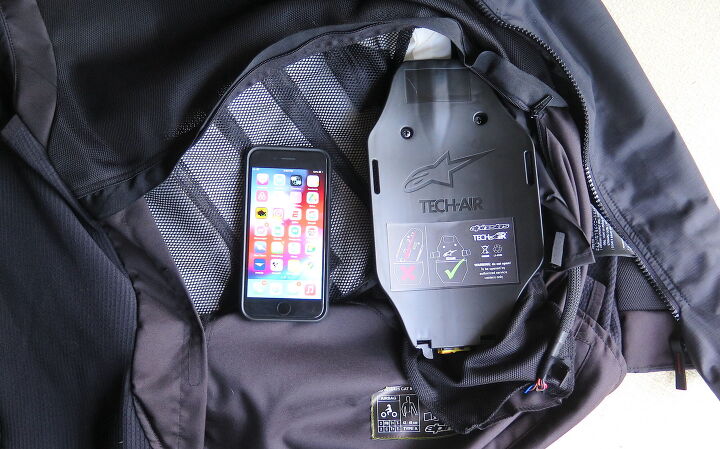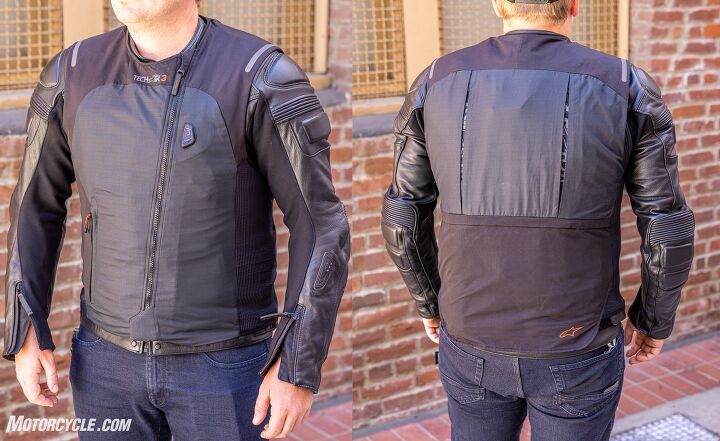Motorsports Racing News & Blog Articles
MO Tested: Alpinestars Tech Air 3 Vest
Maybe think of this as more a second opinion than a review, since Ryan Adams already wrote quite a bit about Alpinestars’ latest Tech Air 3 vest in Best Motorcycle Airbag Jackets last week. While he was posting that, I was attending the Los Angeles premier of the new vest last Wednesday. I haven’t spent enough time in the thing to know how I really feel about it yet, but I can highly recommend The Bike Shed’s breakfast burrito.
Alpinestars Tech Air 3 Vest| Aesthetics | 8/10 | Protection | 9/10 | Comfort | 7/10 |
| Value | 7/10 | Weight | 7/10 | Innovation | 8/10 |
| Quality | 7/10 | Options | 8/10 | Weather | 6/10 |
| Desirability | 7/10 | Editor Score: 74% | |||
| + Highs Nice peace of mind for those who crave it Cool tech that you wear 40 hours per charge is pretty convenient | – Sighs Feels like it’s gonna be hot when it’s hot Not exactly svelte, not exactly light Hope you don’t fall on that canister out back |
First off, since the Tech Air 3 is a vest, it should be easiest and most accessible for everyday use by commuters, pizza delivery people, motorcycle cops, etc. Unlike A’stars other track-ready Air Tech garments, which offer Race and Street modes, the TA3 is hardwired for Street mode only. At $600, it’s also the least expensive in the Tech Air department.
As a ride-to-work garment, it’s designed to be worn under or over your jacket. Okay, but I’d need to get all new jackets a size larger before I’d be able to zip the Tech 3 inside them; the vest isn’t bad, but the “ergonomically designed” canister housing at the left rear of the jacket is way bulkier than I envisioned. When I hear CO2 cartridges, I think of the little tire inflator ones. The Tech Air cartridge is the size of a Costco hotdog, filled with Argon, and its hard plastic housing is 9 x 5 inches. That housing is curved to match your torso, but it’s still nearly an inch thick.

In the earlier Tech Air 5, the canister housing is contained in the built-in back protector. Since the Tech Air 3 doesn’t come with a hard back protector (only a pocket for one), the housing had to find a new home. I’m not certain it’s a good one.
In my size L vest, the cartridge housing stretches clear from my left kidney to the top of my upper butt cheek. Ain’t no way my leather jackets are going to close up over that added bulk at my (already bulky) waist. I did get the vest to fit under my size L Spidi H2O Out Adventure jacket (with all the liners removed). And I can get it inside my new size 44 Aerostich, but not with much room to spare.
Bear in mind, Alpinestars says you need 4 cm clearance around your torso (1.6 inches) for the bag to be able to expand should it need to, and well, I think for most of us this is going to be an outer layer most of the time. So it’s a good thing A’stars says it’s waterproof.

Also, the area that the air bag covers doesn’t seem to include the canister, which hangs low on the left rear. I guess it’s best to think of it as a kidney protector, but a solid one. Meanwhile in front (at left), it’s as if the A’stars designers somehow knew where I already have plenty of padding… Tech-Air 3 System is considered Category 2 Personal Protective Equipment, conforming to standard EN 17092 – 6: 2020.

You can see the outline of the canister on Ryan A’s lower left back. The thing on his left breast is the LED indicator that lights up and vibrates to let you know the status. You can also download the A’stars app into your phone to check status and do a bunch of other modern things like track your rides, automatically update the system…
Couldn’t be much easier
You charge the vest with a USB-C port that plugs into the back of the indicator light on the left front of the vest. Four hours gives a full charge that’s supposed to last 40 hours. One hour’s charge is supposed to be good for 10 hours. From there, all you do is zip up the diagonal front zipper whilst being careful that the front part of the airbag is in place via a small magnet inside. Once zipped, another dime-sized magnet sewn into the right side of the storm flap communicates with the LED indicator, visible in the front, to arm the system. The LED badge lights up blue and gives you a haptic vibration, then a few green blinks, then yellow, then solid blue again, and you’re ready to ride. Very Christmassy. If you’re sitting at your desk, the system will turn itself off after a minute or so. But if you move around and get on your bike, it’s armed ten seconds later. Very spooky.
Street Algorithm
The three accelerometers and three gyroscopes are in communication with the ECU (on back of the vest) 1000 times per second, waiting for you to “encounter shocks or unexpected movements” of a certain kind, whereupon the bag will inflate in 1/20-second. Unlike A’stars other Tech Air garments, which offer Street and Race modes, there is no Race mode in the vest.
In the event the user’s body is subject to a high and/or sudden amount of energy, the System will deploy. This may occur when the motorcycle is involved in an accident, such as when the motorcycle collides with another vehicle or with an obstacle, when the rider loses control or when the rider falls off the motorcycle.
The beauty of the Street mode the Tech Air 3 uses is that it’s also supposed to deploy when you’re stationary and something runs into you. Careful somebody doesn’t come up and slap you heartily on the back; the vest could take that as being rear-ended. The Envelope of Protection for a stationary crash, according to the manual, is from 15 mph and up, and from 45 to 135 degrees to the rear. The same cone of protection applies should you run into something going forward at more than 15 mph.

Your “Envelope of Protection” in a stationary crash, ie being rear-ended, is from 15 mph. At speeds above 50km/h (31 mph) or outside the declared angle, the System is expected to deploy as well, however, outside the Envelope of Protection the System may not be fully inflated before there is contact between the obstacle and the user’s covered areas. If the vest doesn’t activate when a thing hits you at less than 15 mph, it probably will before you hit the ground.
Is it comfortable?
In the middle of a cooling-off October was a wise time for Alpinestars to launch the TA3, and along the Pacific Ocean on an overcast day was even wiser. When it’s coolish outside, no problem. When the temp gets up in the higher ranges, I don’t think the extra layers of fabric and four pounds of bulk atop my bod is going to be as welcome. There are nice accordion stretch panels at the side, and large armholes. But science has not yet found a way to perforate an airbag and have it still be functional. (Really, with all the channels the bag consists of, it doesn’t seem like it would be that hard to let air flow between them.) Other than the extra weight and bulk, the vest isn’t uncomfortable. What might work best when it’s hot is one of those mesh deals the kids like, with just elbow and shoulder protection. Though Alpinestars is of course careful to say the vest is not made for abrasion resistance.
To provide full potential protection, the System must always be worn in conjunction with suitable motorcycling gear and apparel that covers the rider from head to toe, including a helmet, protectors, boots, gloves, and other appropriate protective equipment.

There are nine sizes for men from XXS to 4XL, and the women’s Stella version offers six sizes from XS to XXL, all for $600. The zippered pocket on the right front is handy. (I’m not sure if that’s really Stella.)
Light Off-roadability?
The Tech-Air 3 System can be used off-road IN A LIMITED CAPACITY riding on gravel roads only. For the purpose of using the System off-road, the definition of a gravel road is:
An unpaved road surfaced with gravel. Has a minimum width of 4m (13ft). Has no gradients +/-30%. Has no ruts, steps, or holes greater than 50cm (19.5”) in depth.Natch, safety gear manufacturers must err on the side of caution. Ryan A reported bouncing around “over fairly bumpy terrain (basically a tilled up field) with a few small jumps, and drifts” with no problems.
As many of us are painfully aware, the likelihood of falling off of one’s motorcycle greatly increases on loose surfaces. Even if you don’t run into anything or have much of an impact with the ground (I tend to topple over while stationary on tallish ADV bikes), the airbag very well might still activate. Every time that happens, you’ll be having a new cartridge installed by Alpinestars for $99, and every three times they’re going to insist on replacing the cartridge and the airbag, for $199. Right now that means shipping it back to A’stars HQ in Torrance, California; we’re told an east coast facility should be operating soon.
The Tech-Air 3 Electronic Control Unit records the number of deployments. After the third deployment, the System will permanently indicate a System Fault (displaying a steady red light on the LED Display). The System will remain locked until a full service is performed by an authorized Alpinestars’ Tech-Air Service Centre.
If you’re big into off-road, though, the good news is that A’stars is hard at work on an off-road version of Tech Air right now. Which, when you think about it, isn’t an easy thing to do since, like our A’stars rep pointed out, offroad and MX racing is pretty much a constant crash. I can vouch.
Risk vs reward
All the gear all the time is something I approve of in theory but don’t always practice. I could definitely see myself wearing the Tech Air 3 on days when the MO crew is going to be testing and riding hard in the mountains, or under the Aerostich when traveling. I can also see me leaving it on the hanger most of the time when the temperature’s above 90 and I’m cruising genteelly cross town. Speaking of sweaty, you can wash this one, but only after you remove all the electronics and the airbag, which looks like a pretty Velcro-intensive process.
The view from Curmudgeonville
I hate to write it out loud and put the mouth on myself, but none of the street or offroad crashes I’ve experienced, all at slower speeds, have really ever dented my torso; they’ve always injured my knees, elbows, shoulders, hips and pride. Not that I know it can’t happen. The accident that nearly ended Peter Egan involved falling off his DR650 onto a rock with his chest; he said he thought he was all done breathing. Ouch. The only bone I’ve ever broken was a collarbone, after being tank-slapped off a Kawasaki 30 years ago. The vest would’ve probably saved both of us those injuries, though my collarbone is questionable as this is a vest, only a vest. A’stars says it absorbs up to 95% of an impact force.
For racing at high speed in close proximity to other maniacs, I can definitely see the worth of the air suit. And for the street, it probably can’t hurt. Alpinestars says it wants to remove another barrier to getting more people on motorcycles – that barrier being the danger of the thing. My worry is that adding another expensive piece of must-have gear to the already high price of admission might cause even more aspiring riders to throw up their hands in the face of all that danger, and say why not a nice used Miata? Sad.
At the end of the day, everybody’s entitled to their own risk tolerance, though everybody’s nowhere near being entitled to the same depth of pocket to fend off risk. A couple of my Motorcycle.com compadres have already declared they’ll never ride without an airbag again! As for me, my first experience with this Tech Air 3 doesn’t have me quite convinced. I’ll definitely ride with it, but definitely not all the time. Why do I feel like I’m asking for it?
Shop for the Alpinestars Tech Air 3 here
Alpinestars Tech Air 3 FAQ
Does the vest require ongoing maintenance by Alpinestars? If so, how often does it need to be performed and what is the cost for the service?
Alpinestars recommends the system be inspected at least every two years or after 500 hours of functioning, by Alpinestars or an authorized Alpinestars Tech-Air Service Centre. During the inspection, the airbag and electronic components will be examined. All components are removed from the System and the vest is washed. The diagnostics of the electronic unit are checked (and firmware upgraded, if applicable). The expiration date of the high pressure inflator is checked, and if needed the inflator is replaced. The Airbag is inspected for any sign of wear and/or damage. The system is reassembled into the vest and checked functionally. Expect to pay around $200.
Will Street mode work for the occasional track day?
Not at all recommended. Street mode is calibrated more for slower-speed running into things and things running into you. The lean angles, heavy braking, and other physics experienced on a race track could cause the vest to activate. A’stars makes other airbag garments specifically designed for the track. The Tech Air 5, for instance, gives a bit more coverage and lets you choose between Race and Street modes.
How do you clean the Tech Air 3 vest?
Follow the detailed instructions to remove all the electronic components and the airbag first. Then wash the vest only by hand in 85-degree soap and water. Do not wash in machine, line dry only.
Additional Resources
Crash Tested: Alpinestars Tech-Air 5 Airbag System
MO Tested: Dainese Smart Jacket Review
Best Motorcycle Airbag Jackets
We are committed to finding, researching, and recommending the best products. We earn commissions from purchases you make using the retail links in our product reviews. Learn more about how this works.
Become a Motorcycle.com insider. Get the latest motorcycle news first by subscribing to our newsletter here.
The post MO Tested: Alpinestars Tech Air 3 Vest appeared first on Motorcycle.com.
Copyright
© Motorcycle.com



